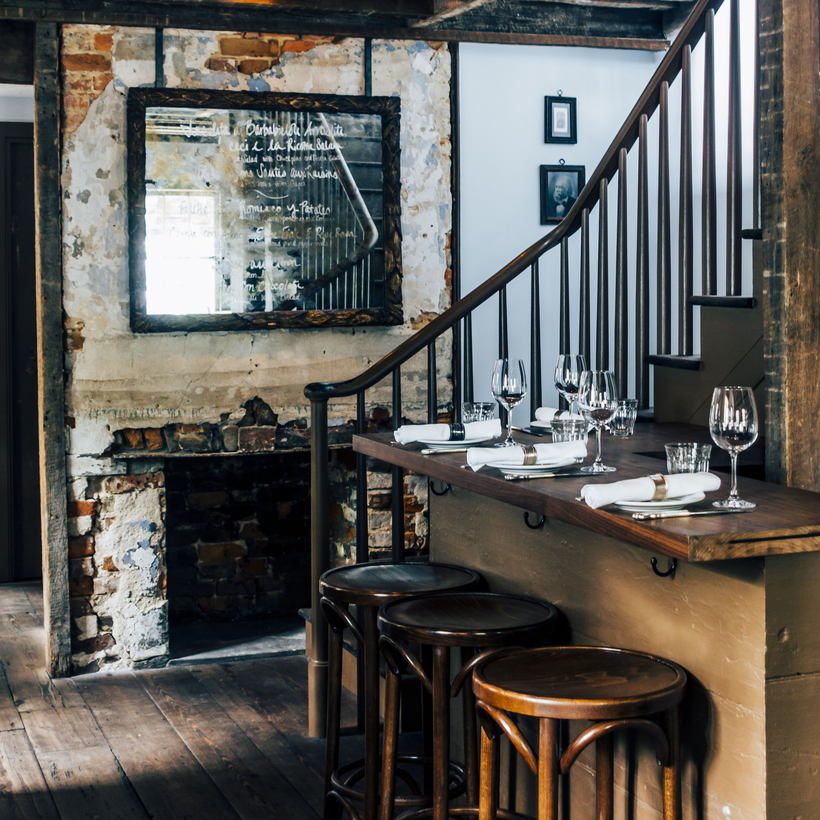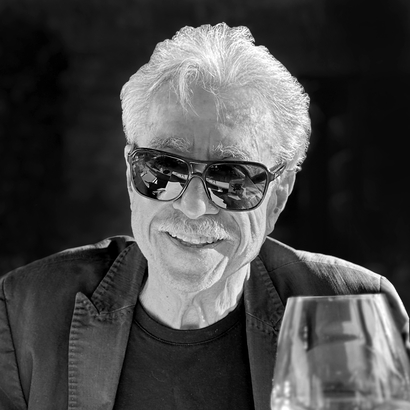There are fancier small restaurants than Chez Nous, and ones much easier to find, unless you are familiar with the back alleys of Charleston, South Carolina. You might not be dazzled by the décor, which is that of an 1835 single-family house lovingly but not extravagantly restored, with only the fireplaces and the wide-plank pine floors left essentially untouched.
There are quirks to dining here. You might impetuously start a conversation with the guests at the table adjoining yours, which will be close enough that raising your voice isn’t necessary. You will likely have difficulty reading the menu, which is written in an artistic cursive script that requires a Rosetta stone to interpret. (I depended upon the remarkably literate waitstaff to come to the rescue.) And should you find yourself seated on one of the long, hard, uncushioned benches that line the walls, you might fantasize that you’re in a church pew from Puritan days.

None of these eccentricities detracts from the excellence of Chez Nous, to me an idyllic small restaurant—welcoming, charming, modest, and serving food that is at once familiar yet somewhat exotic. The high concept (even small restaurants require those) is to offer the cuisines of Northern Italy, northern Spain, and the South of France, all commendable culinary destinations. But what I most admired was not so much the concept but the precision of the cooking, not a misstep to be found.
Fanny Panella, one of the four co-owners of Chez Nous, said the food is reminiscent of her grandmother’s cooking. I presented our differing opinions to the chef, Jill Mathias, and she diplomatically replied, “I believe our dishes are cooked with a grandmother’s precision. No bells or whistles: simple, straightforward, and rustic.”
To me, and I suspect to others who dine out frequently, the small restaurant often becomes a favorite restaurant. It is generally quiet, charming, and friendly, and because I wasn’t certain of my opinion, I contacted David Rockwell, the pre-eminent restaurant architect, and asked him if he felt the same way.

His answer was indirect but definitive. He said, “The building blocks of all my restaurants is the small restaurant. If it’s a large restaurant, the challenge is to make it feel like a series of small restaurants. People love to be in corners. Nobody wants to be at a middle table in the center of a large room.”
Chez Nous seats 10 guests downstairs in what might charitably be called the main dining area, 8 more at the bar, and 18 upstairs. The décor is simple, a few lovely touches here and there—antique photographs, silver napkin rings, those handwritten paper menus. The garden seats 24 outdoors but is vulnerable to changes in weather. If it rains, or even snows—there hasn’t been anything more than a trace of snow in Charleston since 2018—reservations for the outside tables are canceled.
I have had several favorite small restaurants in my lifetime, most in New York. The first was Montrachet, which opened in 1985. Then came JoJo, with Jean-Georges Vongerichten at the stove. Some small restaurants were particularly tiny, like Brooklyn Fare, and some were exceedingly simple, like Lucali, a stellar Brooklyn pizzeria. Later came the original Spring, in Paris, which opened in 2006 with 16 seats. Seating for 55 is what most chefs think of as ideal when they fantasize about opening the restaurant of their dreams.

Chez Nous serves lunch and dinner every day but Monday, offering the same menu regardless of the time of day: two appetizers, two main courses, and two desserts. Repetition is not a concern. Mathias says that before Chez Nous opened, in 2014, the four partners met in what she calls “hypercritical meetings” and came up with 1,200 recipes.
The appetizer that most appealed to me was vitello tonnato, a specialty of the Piedmont region of Italy that consists of cold slices of tender veal topped with a cold white sauce flavored with tuna. This beloved combo was once termed “easily the greatest of all Italian cold dishes” by the woman called “the godmother of Italian cooking,” Marcella Hazan. I’ve eaten vitello tonnato dozens of times in Italy, and no preparation surpassed this one. The same praise can be heaped on a more familiar appetizer of salmon tartare, the diced salmon beautifully surrounded by accoutrements—shallots, capers, chopped egg, and parsley and topped with crème fraiche, a superb luncheon dish. A main course identified on the menu as fish with artichokes and capers worried me inasmuch as the fish was unidentified, but I soon understood why. The fish was local and bore the unfortunate name of wreckfish, although some call it Charleston grouper. It is caught about 90 miles offshore, in an area known as the Charleston Bump. I’ll make this simple: it resembled halibut. Much easier to comprehend was a thick pork-chop entrée, a dish I expected to arrive overcooked because it always is. Not here. Ours had been brined overnight, seasoned, and cautiously pan-seared.

The most startling main course, served on our second visit, was called culotte, no relation to women’s pants. Nor is it particularly well known. This is the best of the top sirloin and quite obviously a favorite of Mathias, as she serves no other steak. Despite misgivings, I ordered it and was quite amazed by its tenderness, juiciness, and appearance. It had marbling, too. Accompanying it was salsa verde, often thought of as Mexican but also common in Italy.
I would suggest that Chez Nous might well be the most appealing small restaurant in America. Although perhaps not when it rains.
A former sportswriter for the Philadelphia Evening Bulletin, Alan Richman has won 16 James Beard Foundation Awards for his journalism on food and wine, and a National Magazine Award for feature writing


